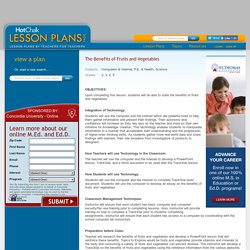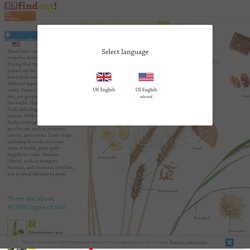

The Benefits of Fruits and Vegetables. Subjects: Computers & Internet, P.E.

& Health, Science Grades: Upon completing this lesson, students will be able to state the benefits of fruits and vegetables. Integration of Technology: Students will use the computer and the internet which are powerful tools to help them gather information and present their findings. How Teachers will use Technology in the Classroom: The teacher will use the computer and the internet to develop a PowerPoint lesson, TrackStar, and a Word document to be used with the TrackStar lesson. How Students will use Technology: Students will use the computer and the internet to complete TrackStar word document. Classroom Management Techniques: Instructor will ensure that each student has basic computer and computer security/fair use training prior to completing lessons. Preparation before Class: Biology of Plants: Introduction. Where Food Comes From.
Durum wheat is grown in many parts of the world.

It is ground into flour to make pasta. Many different shapes of pasta are made from durum wheat. Bread wheat, or common wheat, is the most widely grown type of wheat. This light, brown bread is made from wheat. The rice plant is actually a type of grass. The seeds are the edible part of the rice plant. Chocolate is made from cocoa beans. Rosemary is a fragrant, evergreen herb with needlelike leaves.
The lemon tree is a small evergreen tree that is native to Asia. Sage is a herb that is native to the Mediterranean region, and is now grown throughout the world. The chicory plant is often cultivated for its leaves, which can be used in salads. Herbs are plants that are used to add flavor to food. The cocoa bean comes from the cocoa tree, a tall, evergreen tree native to Central and South America. The coffee plant originally came from Ethiopia, and coffee is still grown there today. What are Fruits & Vegetables? (A Picture Show For Children)
Explanation with photos. Vegetable Song for Kids- Sing along with the lyrics below. Unusual vegetables varieties. Learn about Fruits and vegetables(from min.6:50) Biology of Plants: Parts of the plant we eat. Parts Of Plants we eat. Vocabulary Presentation:Fruits for Children. How do fruit and vegetables grow? This morning on the news I heard that many children (and some of their parents) are unsure of how the fruit and vegetables we eat actually grow.

It’s not all that surprising, since most of us only see fruit and vegetables in beautiful and colourful displays at the supermarket. Unless you have a garden or an allotment and grow your own, you won’t get a chance to see anything as it grows. Until now! There are three main ways a vegetable can grow. Some are roots that grow underground. Other vegetables that grow underground are onions (shown above) and potatoes. The illustration above, taken from an excellent website HERE that shows you how to grow your own potatoes, explains the stages of growth and shows you how the potatoes develop under the ground. The second way vegetables can grow is on a vine. The third way vegetables grow is sprouting up above ground with strong roots holding them up. Another vegetable I can think of that grows on a big tall stalk is sweet corn. Like this: Which fruit grow on vines. How Fruits and Vegetables and Spices Grow.
Top Ten Amazing Fruits that Grow in Weird Ways. Fruits & Veggies More MattersColoring & Activity Pages for Kids - Fruits & Veggies More Matters. Coloring Pages Introduce your children to the energetic Fruit & Veggie Color Champions™ and the basic principles behind Fruits & Veggies—More Matters® with these beautifully illustrated coloring and activity pages.

Eating fruits and vegetables in all forms—fresh, frozen, canned, dried and 100% juice—can be a world of fun! Activity Pages How much of a banana makes a one-cup serving? How many carrots or dried apricots? Use these activity sheets to help you and your children visualize cup equivalents and to help motivate them to increase the number of fruits and vegetables they eat each day. Fruit & Veggie Color Champions™ artwork and downloads courtesy of Kidzsmart Concepts. FRUIT PPT worksheet - Free ESL projectable worksheets made by teachers. FRUIT WHEEL worksheet - Free ESL projectable worksheets made by teachers. Fruits and Veggies—More Matters. Fruits and Vegetables Bulletin Board Resources. Kids Only. Fruit Facts. Healthy Mask - Kids Growing Strong. Fruit & Vegetable Resources (fruitveggie)